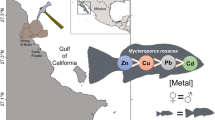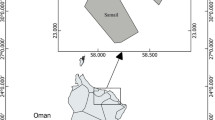Abstract
Snakehead fish (Ophiocephalus argus cantor), silver carp (Hypophthalmichthys molitrtix), crucian carp (Carassius carassius), and common carp (Cyprinus carpio) are four common freshwater fish species in China. In this study, the level of methylmercury (MeHg), total mercury (T-Hg), and total selenium (T-Se) in muscle samples of these four fish species from Ya-Er Lake, China, were analyzed using atomic fluorescence spectrometry coupled with high-performance liquid chromatography, and inductively coupled plasma mass spectrometry. The concentrations of MeHg in all the fish species were significantly correlated with those of T-Hg. Higher T-Hg and MeHg concentrations had accumulated in the snakehead fish, which is a strongly predatory fish, than in the other three species. The concentration ratios of MeHg and T-Hg in the muscles of these four fish species were almost equal. Conversely, there was negative correlation between the concentrations of T-Hg and T-Se, which implies that there is a competition between these two elements with respect to bioaccumulation. It is noteworthy that of all the muscle samples tested, the level of T-Hg exceeded the maximum allowable limit in fish [0.4 mg kg−1 (w/w) recommended by the World Health Organization] in 38.46% of those of the silver carp, 18.18% of those of the crucian carp, and 100% of those of snakehead fish. These results show that the consumption of contaminated fish is a potential threat to human health and that necessary preventive measures to safeguard public health should be emphasized.
Similar content being viewed by others
References
Bakir F, Damluji SF, Amin-Zaki L, et al. (1973) Methylmercury poisoning in Iraq. Science 181:230–241
Barghigiani G, Pellegrini D, D’Ulivo A, De Ranieri S, 1991, Mercury assessment and its relation to selenium levels in edible species of the Northern Tyrrhenian Sea Mar Pollut Bull 22: 406–409
Beijer K, Jernelov A (1978) Ecological aspects of mercury-selenium interaction in the marine environment. Environ Health Perspect 25:43–45
Bloom NS (1992) On the chemical form of mercury in edible fish and marine invertebrate tissues. Can J Fish Aquat Sci 49:1010–1017
Cappon CJ, Smith JC (1981) Mercury and selenium content and chemical form in fish muscle. Arch Contam Toxicol 10:305–319
Chen YW, Belzile N, Guun JM (2001) Antagonistic effect of selenium on mercury assimilation by fish populations near Sudbury metal smelters? Limnol Oceanogr 46: 1814–1818
Cuadrado C, Kumpulainen J, Moreiras O (1995) Lead, and cadmium and mercury contents in average Spanish market basket diets from Galicia, Valencia, Andalucia and Madrid. Food Addit Contam 12:107–118
Culvin-Aralar LA, Furness RW (1991) Mercury and selenium interaction: a review. Ecotoxicol Environ Safety 21:348–364
D’tri FM (1990) The biomethylation and cycling of selected metals and metalloids in aquatic sediment In: Baudo R, Giesy J, Muntau H (eds) Sediments: chemistry and toxicity of in-pace pollutants. Lewis Publ, Ann Arbor, pp 163–214
Eyssen GEM, Ruedy J (1983) Methylmercury exposure in Northern Québec: I. Neurologic findings in adults. Am J Epidemiol 118:461–469
FAO (1983) Fish feeds and feeding in developing countries – an interim report on the ADCP Feed Development Programme. ADCP/REP/83/18.97 FAO, Rome
Galal-Gorchev H (1993) Dietary intake, levels in food and estimated intake of lead, cadmium and mercury. Food Addit Contam 10:115–128
Hall BD, Bodaly RA, Fudge RJP, Rudd JWM, Rosenberg DM (1997) Food as the dominant pathway of methylmercury uptake by fish. Water Air Soil Pollut 100:13–24
Ipolyi I, Massanisso P, Sposato S, Fodor P, Morabito R (2004) Concentration levels of total and methylmercury in mussel samples collected along the coasts of Sardinia Island (Italy). Anal Chim Acta 505:145–151
Liang LN, Jiang GB, Liu JF, Hu JT (2003) Speciation analysis of mercury in seafood by using high-performance liquid chromatography on-line coupled with cold-vapor atomic fluorescence spectrometry via a post column microwave digestion. Anal Chim Acta 477:131–137
Lyle JM, 1986, Mercury and selenium concentrations in sharks from Northern Australian waters Aust J Mar Fresh Res 37: 309–321
May K, Stoeppler M, Reisinger K (1987) Studies of the ratio of total mercury/methylmercury in the aquatic food chain. Toxicol Environ Chem 13:153–159
Michael G (2003) Cases of mercury exposure, bioavailability, and absorption. Ecotoxicol Environ Safe 56:174–179
Monteiro LR, Lopes HD (1990) Mercury content of swordfish, Xiphias glaudius, in relation to length, weight, age, and sex. Mar Pollut Bull 21:293–296
Nakagawa R, Yumita Y, Hiromoto M (1997) Total mercury intake from fish and shellfish by Japanese people. Chemosphere 35:2909–2913
Nriagu JO, Pfeiffer WC, Malm O, de Souza CMM, Mierle G (1992) Mercury pollution in Brazil. Nature 356:389
Parizek J, Ostadalova I (1967) The protective effect of small amounts of selenite in sublimate intoxication. Experiential 23:142–143
Paulsson L, Lundbergh K (1991) Treatment of mercury contaminated fish by selenium addition. Water Air Soil Pollut 56:833–841
Sheline J, Schmidt-Nielsen B (1977) Methylmercury-selenium: interaction in the killifish, Fundulus heteroclitus In: Vernberg FJ, Calabrese A, Thurberg FP, Vernberg WB (eds) Physiological responses of marine biota to pollutants. Academic Press, New York, pp 188–193
Southworth GR, Peterson MJ, Ryon MG (2000) Long-term increased bioaccumulation of mercury in largemouth bass follows reduction of waterborne selenium. Chemosphere 41:1101–1105
Storelli MM, Marcotrigiano GO (2001) Total mercury levels in muscle tissue of swordfish (Xiphias glaudius) and bluefin tuna (Thunnus thynnus) from the Mediterranean sea. J Food Prot 64:1058–1061
Storelli MM, Giacominelli SR, Marcotrigiano GO (2002) Total and methylmercury residues in tuna-fish from Mediterranean sea. Food Addit Contam 19:715–720
Tsubaki T, Irukayama K (eds) (1977) Minamata disease: methylmercury poisoning in Minamata and Niigata, Japan. Elsevier, New York
Turner MA, Swick AL (1983) The English-Wabigoon river system: 4 interactions between mercury and selenium accumulated from waterborne and dietary sources by northern pike (Esox lucius). Can J Fish Aquat Sci 40:2241–2250
WHO (1989) Evaluation of certain food additives and contaminants. WHO Technical Report Series 776, World Health Organization, Geneva
WHO (2003) Summary and conclusions of the 61st Meeting of the Joint FAO/WHO Expert Committee on Food Additives (JECFA). JECFA/61/SC, Rome
US Environmental Protection Agency (EPA) (2001) Water Quality Criterion for the Protection of Human Health: Methylmercury. EPA-823-R-01-001
Acknowledgements
Financial support was provided by the National Basic Research Program of China (grant no. 2003CB415005) and the Chinese Academy of Sciences (grant nos. K3CX2-SW-128, K2CX3-SW-431). The authors are grateful to Mr. Jianbo Shi for his technical assistance.
Author information
Authors and Affiliations
Corresponding author
Rights and permissions
About this article
Cite this article
Jin, L., Liang, L., Jiang, G. et al. Methylmercury, total mercury and total selenium in four common freshwater fish species from Ya-Er Lake, China. Environ Geochem Health 28, 401–407 (2006). https://doi.org/10.1007/s10653-005-9038-5
Received:
Accepted:
Published:
Issue Date:
DOI: https://doi.org/10.1007/s10653-005-9038-5




